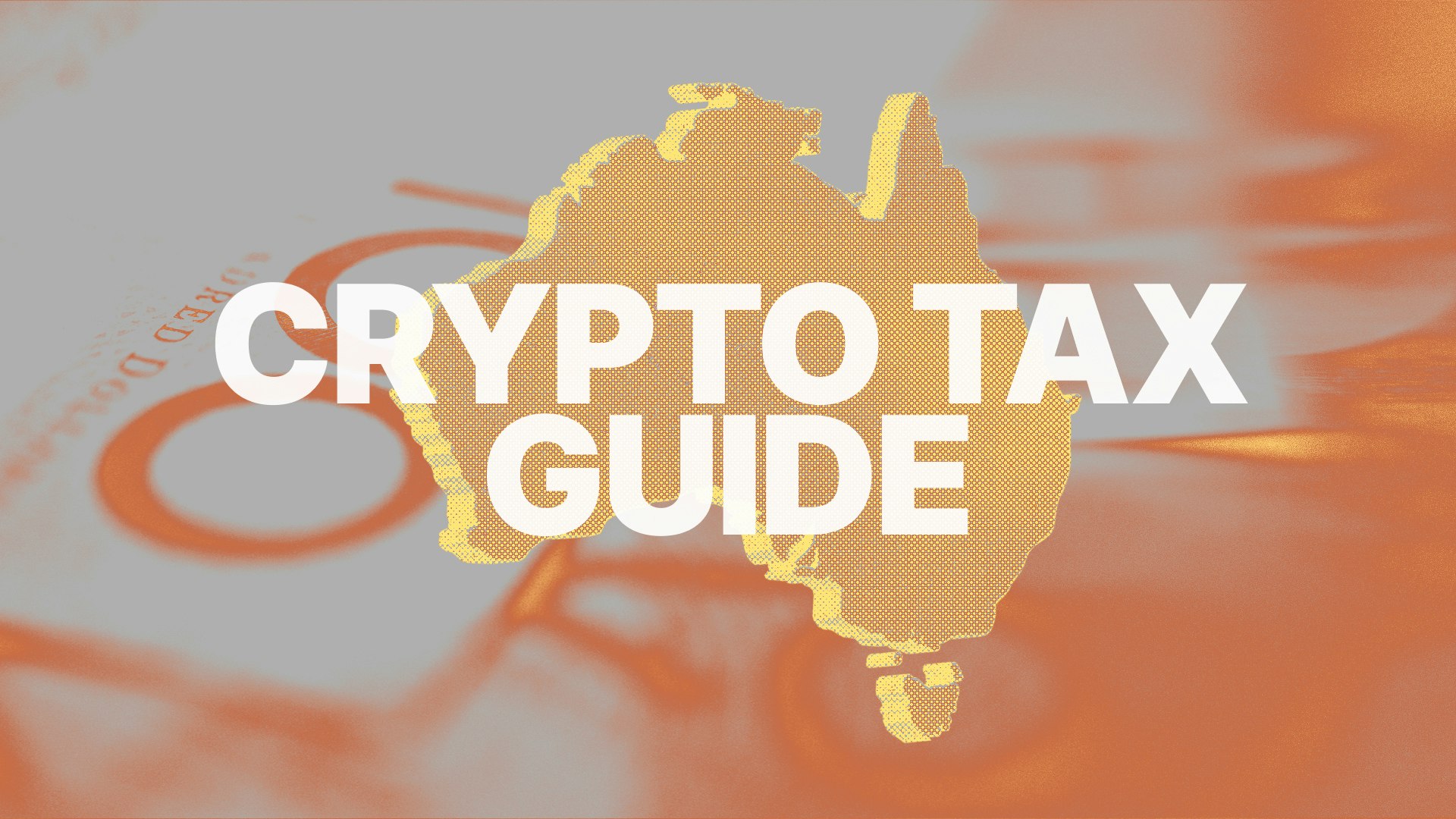Crypto Tax in Australia in 2025: Everything You Need to Know
Crypto tax in Australia is something you need to think about if you have tried your hand at any sort of crypto trading this financial year.
In this article...
- Crypto tax doesn't need to be complicated
- Here are some things to know about crypto tax
- Discounts on crypto tax software are available!

If you’ve engaged in any sort of cryptocurrency transaction over the last year, it’s highly likely that you’re going to have to report it in your tax return. Transactions include, but are not limited to, buying, selling, trading, mining, staking, giving and/or receiving cryptocurrency.
This applies whether the transaction happened in Australia, America or some nameless tax haven in the middle of the Pacific. Basically, if you used crypto, the Australian Tax Office (ATO) wants to know about it.
But actually working out your cryptocurrency tax can be difficult and there are a lot of different facets you need to consider when preparing your tax return.
Yet with the ATO keeping Australian crypto investors squarely in their spotlight, it’s more important than ever that you know what you’re doing and how to report your tax obligations correctly.
Australian crypto tax: A comprehensive guide
To help you on your way, we’ve compiled a comprehensive guide to the current rules surrounding cryptocurrency and tax in Australia.
While this guide is based on the latest information from the ATO (as of 18 June 2024), the information in this article is for general information only. We are not a financial or legal adviser and the information you’ll find below shouldn’t be considered as financial or legal advice.
If you need more specific guidance, you should consider seeking independent financial or legal advice.
Does the ATO track your crypto trades?
Yep, the Australian Taxation Office (ATO) actively monitors cryptocurrency transactions. The ATO has run a crypto-assets data matching program since the 2014-15 financial year, and estimates that it obtains records relating to up to 1.2 million Australian crypto users each financial year. This data is primarily obtained from Australian cryptocurrency exchanges. If you have an account with a crypto exchange, your data probably exists within ATO records.
The data aids in identifying buyers and sellers, quantifying transactions, and comparing against ATO records to uncover tax dodgers. All centralised crypto exchanges have been obligated to report to the ATO since 2018. So don’t be naughty!
Am I an investor or trader?
First thing you need to do is work out whether you’re classified by the ATO as an investor or a trader.
Investor
An investor is someone who is primarily buying and selling cryptocurrencies as a personal investment tool. In this case, your income will be derived primarily from long-term capital gains, as well as staking, forks and airdrops.
The vast majority of people who engage with cryptocurrencies will be considered investors and their cryptocurrency transactions will be subject to Capital Gains Tax (CGT).
Trader
A trader is someone who is conducting a business with the primary purpose of earning income from the buying and selling of cryptocurrency. Rather than assessing each transaction as a capital gains event, traders treat their profits as business income instead.
Becoming a trader isn’t simply a question of trading frequency or volume. It requires actions on your behalf that suggest you, either explicitly or implicitly, see your trading as a business, as well as an assessment from the ATO to the same effect.
You can find more information about the requirements and consequences of becoming a cryptocurrency trader here.
Capital Gains Tax (CGT)
The ATO classifies digital currency as an asset, much like a share in a company or a house, which means that you need to assess your capital gains every time you sell, trade or give away your crypto. We go into all the different types of capital gains events in more detail below.
Note that a capital gains event only occurs when you actually do something with your crypto. If you simply use AUD to buy and HODL, then you don’t need to pay tax on your cryptocurrency, even if the value of your portfolio increases (or decreases) significantly.
Capital Gains
If you make a profit on a transaction, then you’ll need to pay tax on your capital gain. For instance, if you buy 1 Bitcoin at $7,000 (this is what’s known as your “cost basis”) and sell it six months later for $10,000 then you’ve made a capital gain of $3,000 and will need to pay tax on that amount.
Long-term CGT Discount
The Australian Government would prefer it if we weren’t all day-trading on the share/crypto markets and so have implemented what’s known as the long-term CGT discount.
Basically what this means is that if you hold an asset for longer than 12 months then you only have to pay tax on the below % of any capital gains you make from that asset once you deduct any capital losses.
-50% for resident individuals (including partners in partnerships)
-33.33% for complying super funds and eligible life insurance companies
-50% discount is removed or reduced on capital gains made after 8 May 2012 for foreign resident individuals
Returning to the example above, if you are an Australian resident, bought 1 Bitcoin at $7,000 and sold it a year-and-a-half later for $10,000, then your capital gain for tax purposes will only be considered $1,500 rather than $3,000, given that you didn't have any capital losses.
If you had a $1000 capital loss then your capital gain will be $1,000 rather than $2,000. This, it probably goes without saying, can make a big difference to your tax bill.
Capital Losses
If, on the other hand, your cryptocurrency is worth less when you sell it than when you purchased it, you’ve made a capital loss. So, if you buy 1 Bitcoin at $7,000 and then sell it six months later for $4,000, you’ve taken a capital loss of $3,000.
Capital losses can be used to offset capital gains either in the same financial year or in subsequent financial years. Let’s say you made a $5,000 capital gain on one trade and a $3,000 capital loss on another. In this case your overall capital gain is $2,000, because your loss partially offsets the gain.
There’s no time limit to how long you can carry forward capital losses, but they must be used if you make a capital gain in a subsequent year. Capital losses cannot be used to offset your income from work.
Calculating your net capital gains
When it comes to calculating your net capital gains, the ATO doesn’t differentiate between different types of asset, so the profits you make from selling crypto, shares, property or any other asset are all bundled in together.
The formula is simple:
(Total Capital Gains–Total Capital Losses (incl. previous years))
x
Capital Gains Discount (for disposed assets that were held for over 12 months)
=
Net Capital Gains
Resident Tax Rates
2023 - 2024
| Taxable income | Tax on this income |
|---|---|
| Up to $18,200 | Nil |
| $18,201 - $45,000 | 19c for each $1 over $18,200 |
| $45,001 - $120,000 | $5,092 plus 32.5c for each $1 over $45,000 |
| $120,001 - $180,000 | $29,467 plus 37c for each $1 over $120,000 |
| $180,001 and over | $51,667 plus 45c for each $1 over $180,000 |
2024 - 2025
| Taxable income | Tax on this income |
|---|---|
| Up to $18,200 | Nil |
| $18,201 - $45,000 | 16c for each $1 over $18,200 |
| $45,001 - $135,000 | $4,288 plus 30c for each $1 over $45,000 |
| $135,001 - $190,000 | $31,288 plus 37c for each $1 over $135,000 |
| $190,001 and over | $51,638 plus 45c for each $1 over $190,000 |
2025 - 2026
| Taxable income | Tax on this income |
|---|---|
| Up to $18,200 | Nil |
| $18,201 - $45,000 | 16c for each $1 over $18,200 |
| $45,001 - $135,000 | $4,288 plus 30c for each $1 over $45,000 |
| $135,001 - $190,000 | $31,288 plus 37c for each $1 over $135,000 |
| $190,001 and over | $51,638 plus 45c for each $1 over $190,000 |
An investor’s guide to crypto transactions

Moving crypto between wallets
Moving crypto between wallets you own – either privately or as an account holder on an exchange – is not a capital gains event. However, it’s important to keep track of these movements because automated crypto tax software like Summ, Koinly, Syla, KoinX, CoinLedger, CoinTracker or Coinpanda needs a full record of your cryptocurrency’s transfer history in order to produce an accurate tax report.
Say, for example, that you sent one Bitcoin from your CoinJar wallet to a private wallet and then on to a trading wallet on Binance. If crypto tax software can’t account for the transfer to your private wallet, it will assess the passage both too and from the wallet as a taxable event, potentially resulting in a much larger tax bill.
Spending Crypto with Your CoinJar Card: What You Need to Know About Taxes
Your CoinJar Card is a handy way to use your crypto for everyday purchases, both online and in-store. It seamlessly converts your crypto into cash at the time of the transaction, making it feel just like using a regular prepaid debit card.
However, it's important to understand the tax implications:
Whenever you use your CoinJar Card, you're essentially selling crypto to cover the purchase amount. This triggers a capital gains tax (CGT) event, just like any other crypto-to-cash conversion. Depending on whether you make a profit or loss, you'll need to report this in your tax return.
We're aware that this can be a bit inconvenient, especially as crypto spending becomes more mainstream. We're hopeful that tax regulations will evolve to better reflect this new way of using digital assets.
In the meantime, CoinJar is here to help:
We provide easy-to-use summaries of your CoinJar Card transactions, making it a breeze to track your capital gains and losses for tax time. Check out our blog post for more details.
CoinJar also integrates with crypto tax software, which track all of your transactions and can quickly and easily assess your tax obligations.
We suggest using a crypto accounting app such as Summ, Koinly, Syla, KoinX, CoinLedger, CoinTracker and Coinpanda
Personal Use Exemption:
There's a potential exemption to be aware of. If you buy a small amount of crypto (under $10,000) and quickly use it for personal items, like concert tickets or clothes, it might be considered a "personal use asset."
In this case, you wouldn't have to pay CGT on any gains. However, this is a complex area, so be sure to consult the Australian Taxation Office (ATO) website for more information here.
How does tax work for cryptocurrency traders and businesses?
As mentioned above, the vast majority of people who engage with cryptocurrency will be seen as investors by the ATO. However, if you are running an explicitly crypto-oriented business, such as a mining farm, or are operating as a trader rather than an investor, then the rules are different.
Am I a trader?
This question is harder to answer than it might first appear. Simple quantity of trades is not enough to render you a trader in the eyes of the ATO – you must also be operating in a “business-like manner”. While there’s no absolute definition of what constitutes business-like activity, some of the things to look for are:
-
Significant capital investment.
-
A focus on short-term profit generation, as opposed to long-term investment.
-
High volume, repetitive and regular transactions which take place on a daily or weekly basis.
-
Buying and selling behaviour that suggests an active trading strategy.
-
Actually operating in a business-like manner i.e. business registration, strategy documents, office space, business planning, budgeting, consistent asset selection and business-like record keeping.
-
If you satisfy most or all of the above, then it’s likely that you’re operating as a cryptocurrency trader. If you’re uncertain whether you’re acting as a trader or not, we strongly suggest you secure the services of a crypto tax specialist to help work it out.
Can I be both a trader and an investor?
The short answer: Yes. However, if you do want to hold both trading and investing accounts, it’s important to ensure that they exist in separate wallets and experience a minimum of cross-contamination i.e. don’t keep sending coins back and forth between them.
This also means it’s possible to be a cryptocurrency trader and a stock market investor and vice versa.
What does it mean to be a cryptocurrency trader?
Basically, if you’re operating as a cryptocurrency trader it means that you’ll be taxed as a sole trader. Rather than assessing each trade as a capital gains event, sells are seen as trading income, while buys are considered trade purchases. So, much like a regular business, it’s all about income and expenses.
At the end of the year, you’ll tally your income and your expenses – including the difference between the value of your portfolio at the beginning and end of the year – and the profits will be added to your overall taxable income. However, if you make a loss you may be able to deduct that from your other income for the year.
Note that if you’re running an official crypto business – that is, you’ve registered yourself as a company with ASIC for the purposes of trading, mining or any other crypto-related activity – then you’ll pay the Australian company tax rate of 27.5% instead. However, that rate only applies to profits the company has made. Any money you pay out as wages to either yourself or your employees will be deducted from the company’s profits and taxed as personal income instead.
Benefits of being a cryptocurrency trader
Being a cryptocurrency trader gives you access to many of the tax benefits available to small businesses. These include:
Small business tax incentives: These change year to year, but typically offer $1,000 tax offsets and reduced rates to certain classes of small business.
Loss rules: Crypto traders who generate over $20,000 in trades but record an overall loss can often claim this against the rest of their taxable income, allowing traders to claim their trading losses against their regular salary.
Expenses: All business and crypto-related expenses, such as hardware, software, trading fees and subscriptions can be claimed as deductions. Traders can also access the $30,000 small business instant asset write off.
Negatives to being a cryptocurrency trader
Increased likelihood of ATO scrutiny: Given the many tax concessions on offer to crypto traders, the ATO is likely to take a keen interest in your activities.
Extra admin: As a trader, you’re subject to more complex record-keeping and compliance requirements, which can cost both time and money.
This can include: Detailed trading records; a log of work time; clearly defined strategy documents; detailed research notes; and accurate business records.
No long-term capital gains discount: That 50% can really make a difference.
Do I have to register for an ABN/GST?
If you’re classified as a trader then you’ll have to register for a sole trader ABN if you haven’t already, but you only need to register for GST if your annual GST turnover (income before expenses) is over $75k. Cryptocurrency trades are considered to be input-tax sales, which are sales of goods and services that don’t include GST. You can’t claim GST credits for your ‘inputs’ and your cryptocurrency trading turnover doesn’t contribute towards your annual GST turnover.
While you can’t claim GST on your trading per se, you may be able to claim certain business purchases – what are known as reduced credit acquisitions – as well as 75% of any GST paid on brokerage fees. GST compliance can get pretty complex so unless your GST turnover is above $75k per year (in which case you don’t have a choice in the matter), you’ll have to decide whether it’s worth the extra administrative hassle.
Cryptocurrency mining as a business
If you’ve been earning income from mining crypto, then you’ll first have to work out whether you’re running a business or simply mining as a hobby.
Much like with trading itself, there are no hard and fast rules here, but generally if you’re conducting business-like activity – i.e. registering a company, creating business plans, pursuing an active profit model, conducting the same activity in a regular, planned fashion – then the ATO is likely to see it as a business.
For mining, this means that all mined cryptocurrency must be reported as income in Australian dollars at the time that it’s mined. Any income you make from selling or trading the crypto must also be reported. At the end of the year, any stock you have on hand will be measured against the stock you had at the beginning of the year and added to the total.
As a business you’re able to claim expenses such as hardware depreciation, software and electricity costs. You may also be able to claim the small business instant asset write-off, which allows you to claim up to $30,000 of equipment or infrastructure costs as a deduction. Finally, you may be able to claim any losses against your regular income, subject to the rules for non-commercial losses.
Loans, DeFi, interest, staking and other forms of cryptocurrency-related business income
As a basic rule, if you’re receiving, sending, buying, selling or giving away cryptocurrency as part of your business – basically any income or expense rendered in cryptocurrency – then you’ll need to include the proceeds as part of your ordinary income. This means reporting the Australian dollar equivalent of the transaction at the time that it occurs.
However, it’s likely that the business-like nature of each activity will be assessed separately. So, you might be running a crypto mining business, but taking interest on crypto loans as a hobbyist or investor.
Futures, options, CFDs and other derivatives
As a trader, any income you make from systematically trading futures, options or other derivative instruments are treated the same as regular trading – your net gain or loss for the year will be added or deducted from your overall income.
However, if you’re trading derivatives as a hobbyist or gambler, the rules are different. In these cases, your gains might be untaxed, but your losses – which the ATO assumes will be the case, because you’re, well, gambling – can’t be claimed as a deduction.
If this sounds like a loophole, prepare to be disappointed. There’s another class of derivative trader: the speculator. Speculators are the derivative’s version of a straight-up investor. They occasionally trade derivatives with a view to making a profit – i.e. there’s a strategy to their decisions – and their profits or losses will most likely be treated as capital gains or losses.
As with crypto trading more broadly, whether you’re a trader, a speculator or a hobbyist hinges on both intention and practice. This means answering questions like: how business-like are you in your activities? How frequently are you trading? How much capital do you have trade with? How much strategy goes into your decisions?
Like the instruments themselves, derivatives tax is complex (and risky) and there are subtle differences in the treatment of different derivatives, so we suggest you talk to a tax professional both before and after making them part of your trading strategy.
Paying employees in cryptocurrency
Generally paying employees in cryptocurrency is treated the same as normal salary or wages. This means that you need to meet all the regular PAYG and superannuation obligations for the employee based on the Australian dollar value of the crypto you’re paying them.
However, if you have a salary sacrifice agreement in place with the employee, then the crypto payment could be classified as a fringe benefit and you need to take note of the rules surrounding the Fringe Benefits Tax.
Reporting Your Tax
The Australian tax year runs from July 1 to June 30. When you lodge your tax return, you need to include all the crypto transactions that occurred between these two dates.
If you are lodging your own return, it must be completed by October 31 of the same year. If you are lodging through a registered tax agent/accountant you usually have until March 31 of the following year to submit your returns.
It’s important to meet these deadlines, because delays in filing your taxes can lead to penalties, fees and potentially even extra scrutiny from the ATO.
What records do I need to keep?
Whether you’re an investor or trader, it’s vitally important that you keep clear, comprehensive records of all your cryptocurrency transactions. A proper record includes:
-
The date of each transaction
-
The value of the cryptocurrency in Australian dollars at the time of the transaction
-
The purpose of the transaction (i.e. was it a gift, a donation or for personal use?)
-
The details of the other party involved (even if it’s just their crypto wallet address) You should also keep evidence of the following:
-
Receipts of cryptocurrency purchases or transfers
-
Exchange records
-
Invoices for any agent, accountant or legal costs
-
Digital wallet records and keys
-
Any software costs associated with the management of your tax affairs
How can I manage all these transaction records?
If you trade with any regularity, keeping these records can quickly become challenging.
Fortunately, CoinJar now offers comprehensive and easy-to-read EOFY tax statements to its users. All you need to do is:
-Log in to your account
-Go to Settings > General > Reports > Export
-Export account statements, purchase/sale records, and deposit/withdrawal records for specific date ranges.
CoinJar Exchange: Profile drop-down arrow in the top right corner > Settings > Accounts
a) > Accounts > Blue ‘Statement’ button in the top right
b) > Fill History > Report
c) > Fees > Report
d) > Invoices
These reports can be exported as CSV or PDF files, which you can share with your accountant or refer to in completing your income tax return.
Automate your tax return through Summ, Koinly, Syla, KoinX, CoinLedger, CoinTracker or Coinpanda integrations
While most reputable exchanges now offer users the ability to download comprehensive transaction records, compiling them into a single, ATO-friendly document can still present challenges, especially if you’re operating across a number of wallets and cryptocurrencies.
We suggest using a crypto accounting app such as Summ, Koinly, Syla, Koinx, CoinLedger, CoinTracker and Coinpanda.
These programs allow you to keep track of all your transactions in real-time, irrespective of where and when they take place. At the end of the financial year they’ll compile your transaction history into a single document that sets out your capital gains and losses in Australian dollars, allowing you to quickly and easily assess your tax obligations while also monitoring your overall portfolio performance.
CoinJar now offers full, secure transaction integration with Crypto Tax Calculator, Koinly, Syla, KoinX, CoinLedger, CoinTracker and Coinpanda. This means that whenever you buy, sell or trade a cryptocurrency on CoinJar, the transaction will be ported directly to your preferred crypto tax software account, ready for the end of the financial year.
Disclaimer: Summ, Koinly, Syla, BGL, CoinLedger, Coinpanda, CoinTracker, KoinX, Crypto.com Tax and Accointing are not provided by CoinJar. If you use these services, you’ll be subject to the applicable terms and conditions of use for these products, including a separate privacy policy, which may differ from CoinJar’s privacy policy. You should read and understand all applicable terms before using them.
You should read and understand all applicable terms for the above crypto tax software before using them.
Links to third-party websites will open new browser windows. Except where noted, CoinJar accepts no responsibility for the content on third-party websites.
As of 31/01/23, two apps (Accointing and Crypto.com Tax) are still in this testing phase. CoinJar has been unable to verify the accuracy of the tax output calculations, even though they are integrated with our platform.
CoinJar has contacted these specific entities in relation to these inaccuracies and are waiting for acknowledgement and neither have provided an timeframe/update for resolution.
Exclusive CoinJar customer benefits
Syla
Syla delivers Australia-specific crypto tax solutions from qualified tax professionals. Generate tax-optimised ATO reports designed for Australian investors.
CoinJar customer code: COINJARSAVE provides 30% off first-year subscriptions. No expiration, available year-round.
CoinTracker
New customers save 10% on all subscriptions. Valid until April 5, 2026. Activate offer here.
Notice: Customer feedback indicates Blockpit / Accointing and Crypto.com Tax currently generate inaccurate reports for CoinJar accounts.
Important disclaimers
External websites operate independently. CoinJar Australia Pty Ltd provides no warranty regarding tax calculation accuracy from any application. Users bear full responsibility for evaluating information usefulness and accuracy. CoinJar expressly disclaims liability for calculation errors or omissions.
FIFO vs HIFO and changing methods
If you want to change from one method to the other in different financial years, be aware that your crypto tax software might not provide accurate calculations. Changing between HIFO and FIFO within the same financial year for the same asset is usually not allowed.
An example when buying and selling Bitcoin:
You buy Bitcoin at different prices over time.
Sometimes, you sell some of your Bitcoin.
The government wants to tax your profit from selling Bitcoin (the difference between the buying price and the selling price).
FIFO and HIFO – Choosing How to Calculate Profit:
FIFO and HIFO are like different ways to decide which Bitcoin you sold.
FIFO (First-In, First-Out): If you sell Bitcoin, it's assumed you sold the oldest Bitcoin you bought first.
HIFO (Highest-In, First-Out): If you sell Bitcoin, it's assumed you sold the Bitcoin you bought at the highest price first.
Why Sticking to One Method is Important (Even If You Can Change) when using some tax software calculators:
Imagine you kept track of your Bitcoin sales using FIFO for a few years. Then, you switch to HIFO and try to recalculate everything. Here's the problem:
Some sales get skipped
Because of the way HIFO and FIFO is calculated, the tax software might not be able to "go back in time" and correctly identify which Bitcoin that you sold in the past have you or have not already reported capital gains tax on.
You might underpay tax
If some sales are missed, the government might think you made less profit than you actually did. This means you'd pay less tax than you should, which could lead to trouble later.
A solution for switching methods
The good news is that a new feature is being developed to help with this, by the companies that offer crypto tax software. They'll "lock" past transactions where you've already paid tax. This means you could:
Use FIFO for a few years
Switch to HIFO if you want
The software would know not to mess with the old transactions where you already paid tax correctly.
Summ,Syla, CoinTracker and Koinly already support the ability to switch accounting methods between financial years. Koinx is planning to release it in the future.
CoinLedger does not support locking accounting methods, allowing customers to change between HIFO, FIFO, and LIFO across different financial years. Using software that does not support locking accounting methods and changing accounting methods from one year to another can lead to inaccurate calculation of taxes.
What can happen
If you've used one method for a while, it's best not to completely change for all your old Bitcoin transactions.
Instead, you can use their "Method Override" feature to switch to a different method only for transactions that you have not reported tax on (like the Bitcoin you buy and sell this year).
Koinly already has this feature available for beta testing. Simply click on the 'Odd override' button underneath the cost-basis method in your settings.


Suggested Articles

Where to Keep Cryptocurrency: How to Store Crypto
Discover the best ways to store your crypto. Learn about software wallets, hardware options, and essential security practices.Read more
You Can Use Wise to Withdraw Fiat From Select Crypto Exchanges
Having a Wise account now means that you can deposit and withdraw fiat from registered crypto exchanges like CoinJar.Read more
Why is Crypto Crashing? Explaining the Crypto Bloodbath
Why is crypto crashing today? Here is the explanation of some of the blow-up.Read moreBrowse by topic
Disclaimer: This article is for informational purposes only and does not constitute financial or investment advice. Cryptocurrencies, including Bitcoin, are highly volatile and speculative assets, and there is always a risk that they could become worthless.
Readers should conduct their own research and consult with a qualified financial advisor before making any investment decisions.
CoinJar does not endorse the content of, and cannot guarantee or verify the safety of any third party websites. Visit these websites at your own risk.
Your information is handled in accordance with CoinJar’s Collection Statement.
CoinJar’s digital currency exchange services are operated by CoinJar Australia Pty Ltd ACN 648 570 807, a registered digital currency exchange provider with AUSTRAC.
CoinJar Card is a prepaid Mastercard issued by EML Payment Solutions Limited ABN 30 131 436 532 AFSL 404131 pursuant to license by Mastercard. CoinJar Australia Pty Ltd is an authorised representative of EML Payment Solutions Limited (AR No 1290193). We recommend you consider the Product Disclosure Statement and Target Market Determination before making any decision to acquire the product. Mastercard and the circles design are registered trademarks of Mastercard International Incorporated.
Google Pay is a trademark of Google LLC. Apple Pay is a trademark of Apple Inc.
This site is protected by reCAPTCHA and the Google Privacy Policy and Terms of Service apply.

